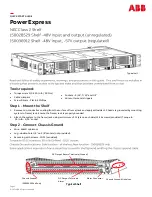
ABB Distribution Protection Unit 1500R
7-6
Records
9/99
website:www.abb.com/papd
Example of a Self-Test Failure
Value : 256 has a binary bit pattern of 0000000100000000 (bit order 15........0)
The 1 is in bit position 8 as you count from the right. This bit position correlates to DSP ROM failure.
Example of an Editor Access
Value : 145 has a binary bit pattern of 0000000010010001 (bit order 15.........0)
The 1s in this bit pattern have the following bit positions and corresponding Editor Access Status:
Bit 0 : Interrupt logging bit (ignore this bit because it will always be set in this example).
Bit 4 : Front communications port initiated the editor access and change.
Bit 7 : Real-time clock settings were changed.
DPU1500R Settings Tables Diagnostics
Three copies of each settings table are stored in a nonvolatile memory device, preventing data loss during control power
cycling. When you finish editing any settings table, the changed table’s data is transferred from a temporary edit buffer
into three separate locations in the nonvolatile memory device.
A background diagnostics task continuously runs a checksum on each copy of the settings tables to verify data
consistency. If an invalid copy is detected, the diagnostic task attempts self-correction by transferring a valid copy to
the invalid copy location. If this is unsuccessful, the task marks the copy as unusable and switches to the next
available copy.
When the DPU1500R detects that all three copies of a settings table are not valid, the diagnostic task adds a self-
diagnostic error in the Operations Record, drops the self-check alarm and disables all protective functions. In
addition, the Self Test display under the MMI Test Menu shows the current status (PASS or FAIL) for all memory
devices.
Examples of bit interpretation are shown below.











































